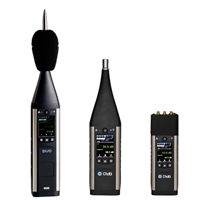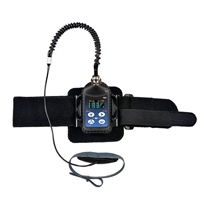Noise, Sound and Vibration Monitors
Sound Level Meters and Noise Dosimeters
Excessive workplace noise exceeding Work Health and Safety Regulations can cause a range of health issues including temporary or permanent hearing loss or tinnitus should noise levels not be correctly managed or failure to implement hearing protection. A noise monitor calculates noise levels by calculating the pressure of the sound waves from the source of the noise. The most common instruments used for measuring noise are the sound level meter (SLM), the integrating sound level meter (ISLM) and the noise dosimeter.
Conducting noise assessments with a sound level meter or noise dosimeter can assist in:
- Identifying workers at risk of hearing loss.
- Determining the noise source or process source causing the risk through noise and vibration moitoring.
- Identifying any noise control measures that are required to be implemented to protect workers.
- Confirming the effectiveness of existing control measures and whether these need to be adjusted to ensure better protection.
Personal Noise Dosimeters and Sound Level Meters
Excessive workplace noise exceeding Work Health and Safety Regulations can cause a range of health issues including temporary or permanent hearing loss or tinnitus should noise levels not be correctly managed or failure to implement hearing protection. A noise monitor calculates noise levels by calculating the pressure of the sound waves from the source of the noise. The most common instruments used for measuring noise are the sound level meter (SLM), the integrating sound level meter (ISLM) and the noise dosimeter.
Our product range includes:
- Calibrators and Accessories – To ensure noise measurements are accurate and legally compliant with noise regulations, it is important to calibrate the sound meter before and after taking measurements. There are two types of calibrations, one that is carried out before each measurement using a reference acoustic source such as the QC-10 Acoustic Calibrator from 3M. The second type of calibration is called periodic verification where the instrument is returned to the calibration laboratory for recalibration. Air-Met Scientific offers a range of acoustic calibrators and accessories to assist with your noise monitoring requirements.
-
Noise and Sound Monitors - Noise monitors are used to measure noise in various industrial applications. This is to ensure noise levels are within the set standards and workers are protected against the risk of hearing damage. The instruments commonly used to measure noise are sound level meters (SLM), integrating sound level meters (ISLM) and noise dosimeters. Air-Met offers a wide range of Personal Noise Dosimeters and Sound Level Meters. Whether you are looking for low-cost and easy to use noise monitors such as the NI 100 Noise Indicator or a noise monitor with a waterproof microphone for more complex noise monitoring applications, Air-Met Scientific has the range and experience to help you select the best instrument for your application.
-
Vibration Meters – Vibration meters are available in two categories, whole-body vibration and hand-arm vibration. Whole Body Vibration is measured through the use of an accelerometer which is placed within the seat pad the operator sits on. The SV 100A Wireless Whole-Body Vibration Exposure Meter is a suitable device for taking measurements on the seat and seat-back. Hand-arm vibration is caused by operating hand-held power tools or by holding materials being processed by machines. The SV 103 Personal Human Vibration Exposure Meter is the world’s first HAV exposure meter. It can be attached to the user’s arm to measure personal vibration in the workplace. Vibration meters are used to ensure employees are not overexposed to vibration due to the operation of machinery. It is used as a countermeasure to prevent health risks caused by vibration such as back pain, damage to nerves and aggravation of existing injuries.
To find the right sound level meters or noise dosimeter for your workplace monitoring needs, contact our team at one of our six locations across Australia today.
Noise, Sound and Vibration Frequently Asked Questions
Here are some FAQs on the sound, noise and vibration monitoring equipment. If you can’t find the answers here, get in touch and our team will be happy to help.
Yes, Air-Met Scientific offers a wide range of noise and sound measurement equipment, including dosimeters, sound level meters, noise monitoring systems, and more. They provide these instruments for hire or purchase.
Interested in renting sound, noise and vibration monitoring equipment? Contact your local Air-Met Scientific Rental office to discuss your monitoring requirements. Air-Met Scientific have rental offices in most major cities including Melbourne, Sydney, Brisbane, Mackay, Perth and Adelaide.
A sound level meter is an instrument that measures sound pressure levels in decibels (dB) and provides instant feedback on the noise levels in an environment. It is typically used for short-term noise measurements, such as to assess noise levels in a factory, concert, or construction site. A sound level meter usually has a microphone that measures the sound pressure level and a display that shows the current sound level.
A noise dosimeter, on the other hand, is a personal noise monitoring device that is worn by an individual to measure their personal exposure to noise over a period of time, such as a full work shift. It measures sound levels and calculates the individual's dose of noise exposure over time, considering both the intensity and duration of the noise. The noise dosimeter is typically smaller and more portable than a sound level meter and can be attached to a worker's clothing or belt.
Occupational noise level monitoring is the process of measuring and assessing the noise exposure of workers in the workplace. This involves the use of sound level meters and noise dosimeters to measure the sound pressure levels in the environment and calculate the amount of noise exposure that workers are receiving.
The aim of occupational noise level monitoring is to identify the potential risks to workers from excessive noise exposure, and to develop strategies to mitigate those risks. By monitoring the noise levels in the workplace, employers can identify areas where noise levels are high, assess the risk of hearing damage to workers, and implement measures to reduce noise exposure.
Class 1 and Class 2 are standards for sound level meters established by the International Electrotechnical Commission (IEC) and followed by many countries, including Australia. The difference between a Class 1 sound level meter and a Class 2 sound level meter lies in their accuracy and capabilities.
Class 1 sound level meters are the most accurate and precise type of sound level meter. They are typically used for measuring noise levels in highly regulated environments such as industrial workplaces, construction sites, and research applications. Class 1 sound level meters have a measurement range of 10 to 140 decibels (dB) and an accuracy of ±1.4 dB.
Class 2 sound level meters such as the TSI Sound Detector SD-200 are less accurate than Class 1 meters but are still very reliable and precise. They are often used in applications such as environmental noise monitoring, occupational noise exposure assessments, and building acoustics. Class 2 sound level meters have a measurement range of 10 to 130 dB and an accuracy of ±2.0 dB.
Hand-arm vibration meters and whole-body vibration meters are two types of instruments used to measure vibration exposure in the workplace. The main difference between the two is the body part that is exposed to the vibration.
Hand-arm vibration meters are used to measure the amount of vibration transmitted to the hands and arms of workers who use hand-held power tools, such as jackhammers, grinders, and sanders. Whole-body vibration meters, on the other hand, are used to measure the amount of vibration transmitted to the whole body of workers who operate vehicles or machinery, such as trucks, tractors, and forklifts.
Hand-arm vibration meters and whole-body vibration meters are generally used in industries where workers are exposed to high levels of vibration, such as construction, mining, manufacturing, and transportation.
In Australia, several industries have regulations on noise levels and require noise level monitoring to ensure that workers are not exposed to harmful noise levels. Some of these industries include:
- Construction: The construction industry is one of the most regulated industries when it comes to noise levels. Construction sites are often noisy environments, and workers can be exposed to high levels of noise from heavy machinery, power tools, and other equipment.
- Mining: The mining industry is another sector that is subject to regulations on noise levels. Heavy machinery, drilling, blasting, and other mining activities can create high levels of noise that can be harmful to workers.
- Manufacturing: Many manufacturing processes involve noisy equipment and machinery, such as conveyors, presses, and cutting machines. Workers in these industries can be exposed to high levels of noise, which can lead to hearing loss if not properly monitored.
A noise survey is an assessment of the noise levels in a particular environment, such as a workplace or community. The purpose of a noise survey is to identify and evaluate the sources of noise and determine the potential risks to human health and well-being.
A noise survey typically involves the use of sound level meters or noise dosimeters to measure the sound pressure levels in the environment. The measurements are taken at various locations and times to obtain a representative sample of the noise levels over time. The data is then analysed to determine the average and peak noise levels and to identify any areas where the noise levels exceed recommended exposure limits.


.jpg)

